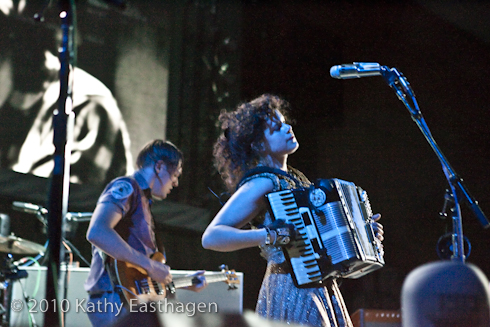
Never have I witnessed such a rapturous reception as the one that greeted the Arcade Fire on a rainy Wednesday night in St. Paul. Example: the sold-out arena’s exultant populace rose to its feet, from ringside to rafters, and even cheered the arrival of new songs. No one ever wants to hear the new songs at a concert! And while the evening’s goodwill quotient gave the impression that some sort of long overdue homecoming was taking place (not so for this beloved Canadian six-piece), let’s submit this as proof that the Arcade Fire’s new one, The Suburbs, is a smash. Don’t take for granted that it had to be so: had they delivered a dud, their star would now be falling at the rate of its current rise, multiplied by gravity. 5,000 Arcade Fire fans could be wrong, conceivably, but the 5,000 in attendance at the Roy recognized a remarkably consistent (if small) body of work. And the band fed off that energy, but of course their real energy came from the knowledge that they did it—really did it!—made a new album full of worthy additions to their setlist.
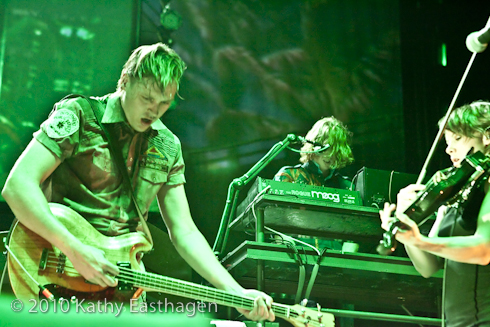
The obvious yardstick for the success of an Arcade Fire show in the year 2010 is their Madison Square Garden appearance back in August, streamed live on YouTube, and pulled off so masterfully that I was made unreasonably giddy and ready to declare them the first “only band that matters” since The Clash, despite the specter of perpetual rebuffering. Well, their St. Paul appearance was much like that one, down to the nearly identical setlist, but scaled smaller and minus the talents of violinist and stringmaster extraordinaire Owen Pallett.
Scaled smaller, but by no means small. The band is now at the point in their career when they can make their live show as huge as they’ve always wanted it to be. So: the sets are elaborate (there’s something Kraftwerk-ian about the platform that holds the drums and piano) while still conveying aspects of the run-down, rusty, backwards-looking ethos of their new album (hence a small-scale replica of a drive-in movie screen, on which is projected a mélange of live footage and wistful Americana). The costumes are tailored and cohesive, the lighting is intricate (at one point—and boy, this was neat—the group’s jagged silhouettes appeared as a cubist panorama in the narrow band between their corporeal selves and the drive-in screen). And, most importantly, the sound is arena-loud, the kind of loud that agitates every molecule of air without quite blasting your ears. At the Roy, the drums boomed loudest of all (the rotation of band members among many instruments allowed the use of multiple drum sets—double drummers!—on a number of songs), making the chorus of “Rococo” the apocalyptic mantra it just fails to be on record, but, on the other hand, stifling the fragile, joyous rattle of “Neighborhood #2 (Laika).”
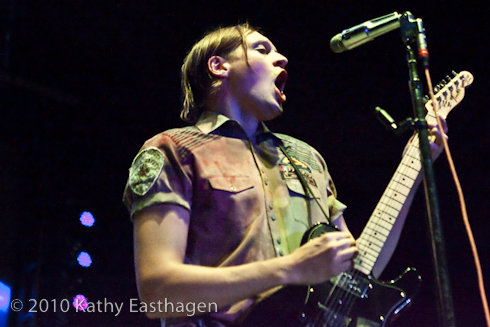
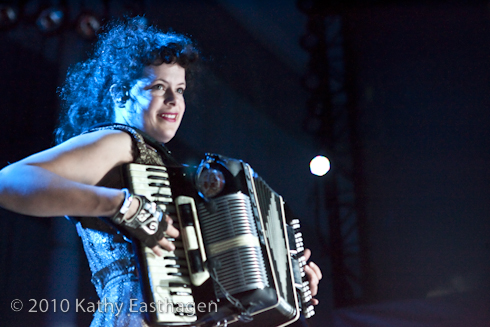
Those two songs found singer Win Butler in characteristic true believer mode. The band’s other occasional lead vocalist, Regine Chassagne, is their secret weapon, though not really a weapon at all—unlike Butler, she doesn’t seek you out in your own home, but reins you in with her charms. She dances and twirls with wonderment—sometimes with ribbon wands, as during the coda of dance classic “Sprawl II (Mountains Beyonds Mountains)”—she sings with the greatest wise child voice since Poly Styrene, she is the lightness in the dark chambers of Win’s heart, and our own. In “The Suburbs,” Butler asks for a daughter to whom he can show the world’s beauty before it’s gone, and if not a daughter, a son. I have a more modest request, that my son or daughter experiences his or her first rock show on a night like the one I’ve described, as it seemed a perfect opportunity to witness the number of life’s fellow travelers who feel deeply in arenas.
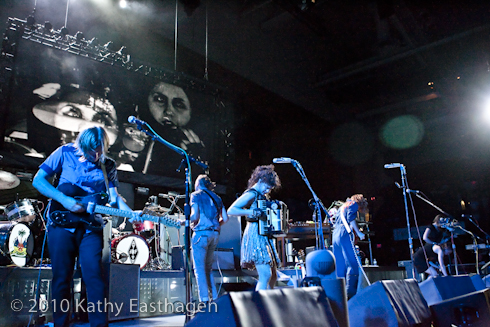
Toward the end of their set, Butler declared himself a longtime fan of opening act Calexico, though anyone not familiar with that band’s long history (going back to the mid 90s, and running concurrent with Friends Of Dean Martinez, the other project of Arizonan multi-instrumentalists Joey Burns and former Giant Sand drummer John Convertino) might have assumed the inspiration ran in the other direction. Because odd as the pairing might have seemed at first blush, Calexico proved the ideal openers, able to deliver the sort of backbeat-heavy, arena-ready anthems the audience was ready to hear. Even their setlist echoed the kind of progression you might find on an Arcade Fire album, the darkly dramatic opening one-two punch of “Frontera” and “Trigger” (think “Black Mirror”) giving way to the rousing, strummy “Deep Down” (think “Keep the Car Running”). But of course these songs predate my imperfect analogies, and the band, complete with vibraphone and trumpet section, didn’t entirely eschew their Latin leanings or the wide-open and windblown idiosyncrasies of their sound. The clear highlight was the back-to-back covers of Love’s “Alone Again Or” and Minutemen’s “Corona,” two Southern Californian classics flavored just right for Calexico’s thirst.
Arcade Fire:
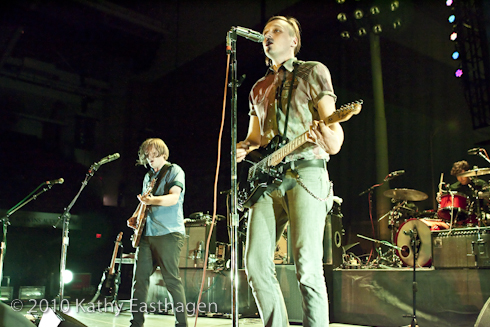
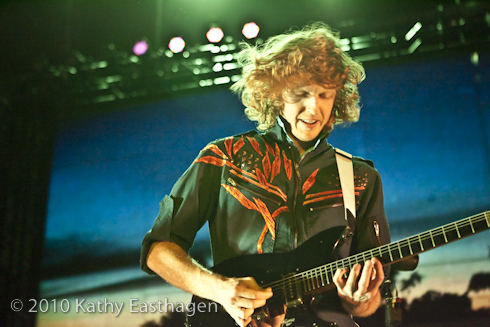
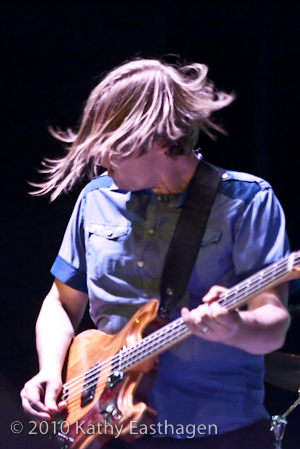

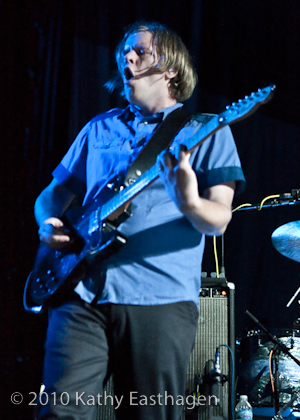
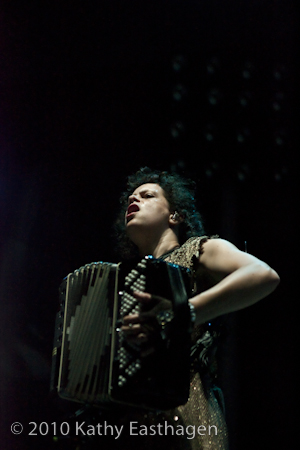

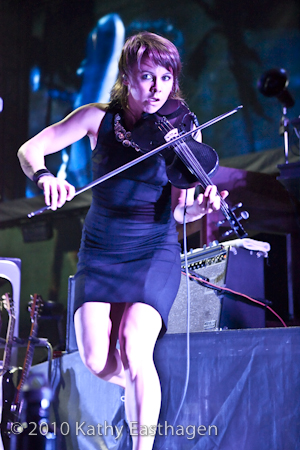
Setlist:
Ready to Start
No Cars Go
Haïti
Rococo
Neighborhood #2 (Laika)
Modern Man
Deep Blue
The Suburbs
The Suburbs (Continued)
Intervention
We Used to Wait
Neighborhood #3 (Power Out)
Rebellion (Lies)
Month of May
Sprawl II (Mountains Beyond Mountains)
Keep the Car Running
Neighborhood #1 (Tunnels) (Encore)
Suburban War (Encore)
Wake Up (Encore)